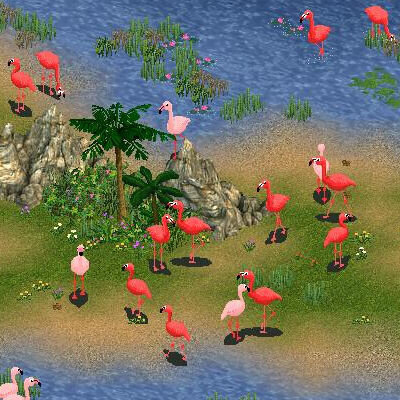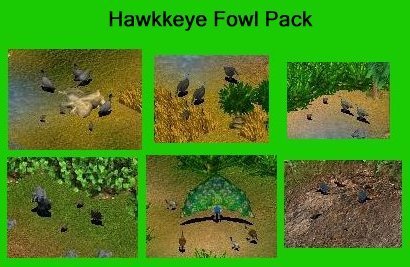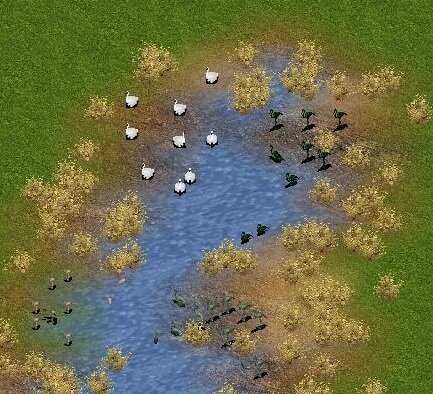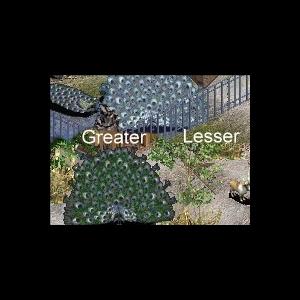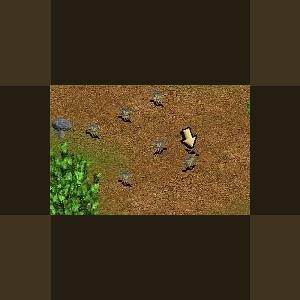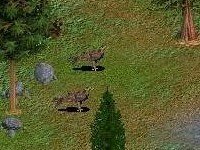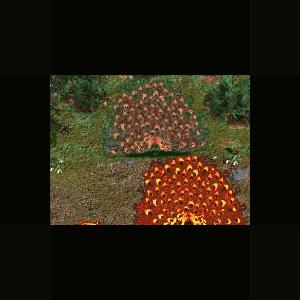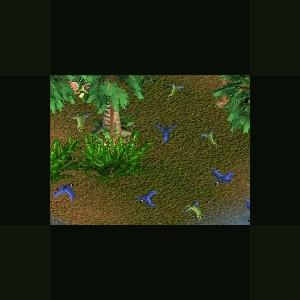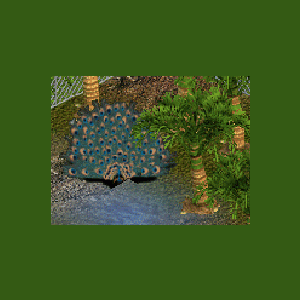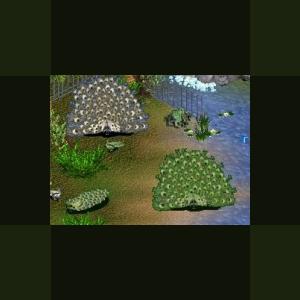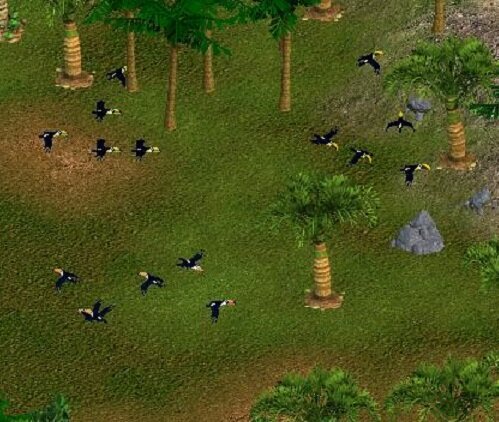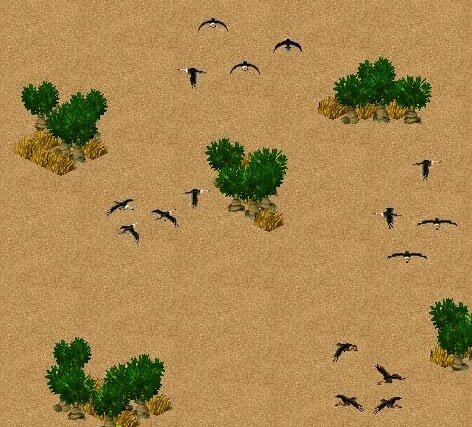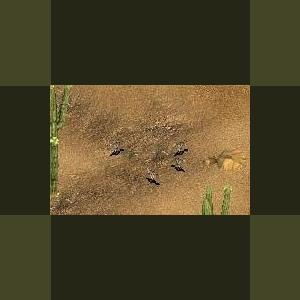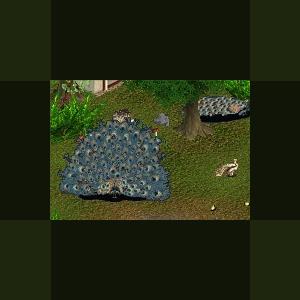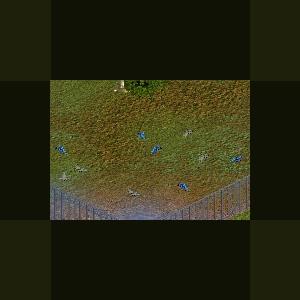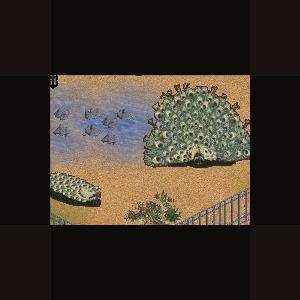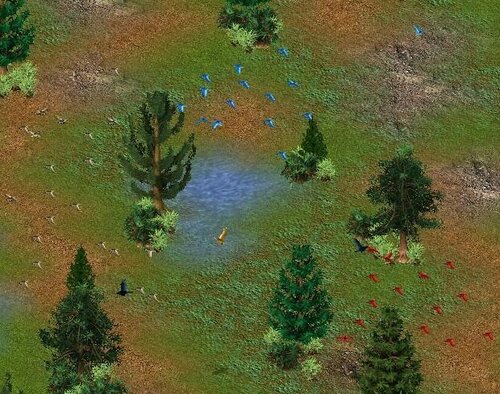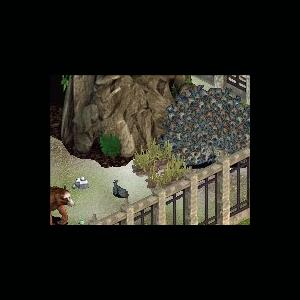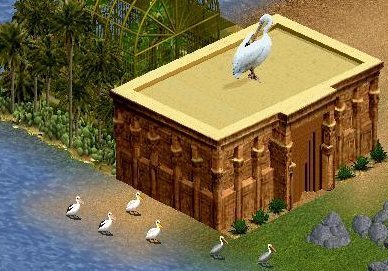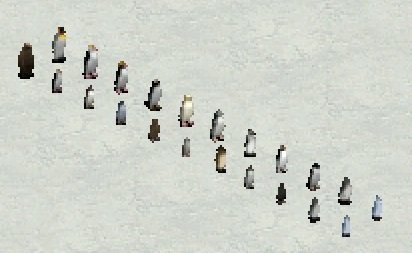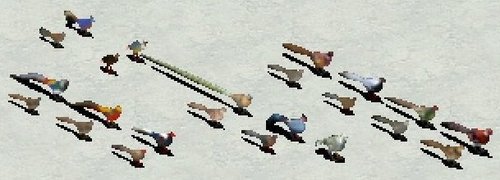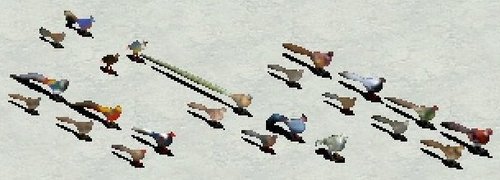Birds
Creatures on the wing
65 files
-
Flamingo Mini-Pack by msc3323
By Cricket
This Mini-Pack contains the American Flamingo and the Rosy Flamingo (Greater Flamingo). Unfortunately they are somewhat big, but real beauties.
Updated by Jay in May of 2020:
From Jay:
Here is the updated flamingo mini pack. Since I do not like apostrophes or spaces in zip file names, I removed the apostrophe and changed the spaces to underscores. Although I do not like apostrophes or spaces in ztd file names either, I did not change that file name. I added English animal info, put the German animal info into paragraphs, reduced the amount of space needed for the flamingos, changed the location for the American Flamingo from Africa to North America, changed the needed food from hay to fish, added the small rock as a specifically liked rock, changed the Rosy Flamingo name in English to Greater Flamingo, and removed unnecessary files and configuration lines.
114 downloads
Updated
-
Fowl Pack by Hawkkeye
By Fern
Fowl Pack
Author: Hawkkeye
Current ztd dates:
- combined/FowlByHawkkeye.ztd: August 2, 2021
- CommonPeafowlByHawkkeye.ztd: August 2, 2021
- CrestedGuineafowlByHawkkeye.ztd: August 2, 2021
- HelmetedGuineafowlByHawkkeye.ztd: August 2, 2021
- HimalayanMonalByHawkkeye.ztd: August 2, 2021
- OcellatedTurkeyByHawkkeye.ztd: August 2, 2021
- WildTurkeyByHawkkeye.ztd: August 2, 2021
Compatibility: All Game Versions except the Ocellated Turkey which requires DD, CC
Description: Six birds from the fowl group: Common Peafowl, Crested Guineafowl, Helmeted Guineafowl, Himalayan Monal, Ocellated Turkey, Wild Turkey
Common Peafowl, one of the most beautiful birds in the world. They live in small groups and like rainforest fern in their exhibit.
Crested Guineafowl is species of guineafowl from Africa. Crested Guineafowls prefer to live in pairs or groups.
The Helmeted Guineafowl is the most well-known species of guineafowl family. They live in forested and shrubby areas throughout most of Africa south of Sahara Desert.
Himalayan Monals live in groups and like highland environment.
Adopt an Ocellated Turkey, smaller relative of better known Wild Turkey endemic to Yucatan peninsula.
Adopt a Wild Turkey and prepare yourself for Thanksgiving! Guests like turkeys with potatoes and stuffing.
Compatibility: Himalayan Monal: Borsato´s Chinese Pangolin.
394 downloads
0 comments
Updated
-
Galapagos Penguin ~ Phoenix ~ Humbolt Penguin by Jordan
By Savannahjan
Galapagos Penguin - Spheniscus Mendiculus, have a narrow white band from the eye extending under the chin and a black band that runs in an inverted horseshoe shape around their fronts. Galapagos penguins breed on the Galapagos Islands on the equator and on the north coast of Isabela Island just north of the equator. Galapagos penguins are believed to eat mostly fish such as mullet and sardines.
The Humboldt penguin is often called the Peruvian penguin, although they are also found in Chile. It lives on the rugged coast and offshore islands of Chile and Peru.
Updated 2010-11 to save space with less in zip.
64 downloads
0 comments
Submitted
-
Great Blue Heron~Black Stork~Long-billed Crulew~Trumpeter Swan by Genkicoll
By Savannahjan
Also includes scrub brush foliage, preferred by the Long-billed Curlew.
The largest and most widespread heron in North America, the Great Blue Heron can be found along the ocean shore or the edge of a small inland pond. Although the Great Blue Heron eats primarily fish, it is adaptable and willing to eat other animals as well. It nests in colonies, sometimes as a lone pair.
Source: http://www.allaboutbirds.org/guide/Great_Blue_Heron/lifehistory
The Black Stork has shining black with iridiscent reflections. The rest of the plumage is pure white with red beak and feet. It can be found hroughout Europe, north to Scandinavia and west to Russia, and is primarily a forest species hunting in streams, small rivers and marshy ponds. The diet consists almost completely of small fish; also small mammals, reptiles, shellfish and insects.
The Long-billed Curlew (Numenius americanus) is the largest shorebird in North America. It breeds in shortgrass or mixedgrass to very dry grasslands. Long-billed Curlews are a late-maturing, long-lived species with low reproductive output. Eggs are olive-buff and are evenly spotted with brown or gray.
Source: http://www.abheritage.ca/abnature/speciesatrisk/curlew_intro.htm
The Trumpeter Swan, Cygnus buccinator, is the largest native North American bird, and the largest living waterfowl species on earth. These birds have white plumage with a long neck, a black bill subtly marked with salmon-pink along the mouthline, and short black legs. They feed while swimming. The diet is almost entirely aquatic plants. The Trumpeter Swan is listed as threatened in the state of Minnesota.
Inspired by the Zoo Tycoon Brains Trust at Zoo Tek Phoenix.
Updated 2010-11-21 to save space with less in zip.
86 downloads
0 comments
Submitted
-
Greater and Lesser Slate-backed Peafowl by Genkicoll
By Guest
Greater Slate-backed Peafowl
Found in the Himalayas. The grayish color of its feathers allow it to blend into its rocky habitat.
Slate-backed have shorter tails and have better flight ability than other peafowl. This allows them to fly from niche to niche, where they often make their roosts and nests. The bulky tails of the India Blue would easily be caught by the high winds, ripping the birds from their perches.
Slate-backed males lose their long tail feathers in late summer and regrown them in early spring. In spring, their mating calls can be heard throughout the mountains. During their short-tailed seasons, it's often hard to tell males and females apart.
Slate-backs usually pair off rather than have harems, mating for life. Depending on the male, he will either take turns brooding the eggs or bring food to his mate (and later chicks). Hens usually lay one or two eggs, under an overhang that can only be reached by flight.
Greater Slate-backs prefer the coniferous forests over the rocky cliffs that the lesser prefer, however, they are equally comfortable in the lesser slate-backs' habitat. The green lazing their trail allows for better blending in.
They make a diet of the pine seeds, berries, and fungi found on the forest floor.
NOTE: 100% compatible with both the Markhor and the Lesser Slate-backed Peafowl
Lesser Slate-backed Peafowl
Found in the Himalayas. The grayish color of its feathers allow it to blend into its rocky habitat.
Slate-backed have shorter tails and have better flight ability than other peafowl. This allows them to fly from niche to niche, where they often make their roosts and nests. The bulky tails of the India Blue would easily be caught by the high winds, ripping the birds from their perches.
Slate-backed males lose their long tail feathers in late summer and regrown them in early spring. In spring, their mating calls can be heard throughout the mountains. During their short-tailed seasons, it's often hard to tell males and females apart.
Slate-backs usually pair off rather than have harems, mating for life. Depending on the male, he will either take turns brooding the eggs or bring food to his mate (and later chicks). Hens usually lay one or two eggs, under an overhang that can only be reached by flight.
A subspecies of the Greater Slate-back, Lesser Slate-backs prefer the the rocky cliffs. Their trail lacks the vibrant green of the Greater, and the coloring has less contrast than what most peafowl are known for. This allows for blending in with the gray rock.
Lesser depend more on insects and lichen than their forest-dwelling brethern.
NOTE: 100% compatible with both the Markhor and the Greater Slate-backed Peafowl
Updated 2010-11-21
Just to save space with less in zip and smaller image.
Nothing new.
325 downloads
0 comments
Updated
-
Greater Roadrunner by MoonDawg
By Guest
Roadrunner species generally range in size from 18 inches (46 cm) to 24 inches (61 cm) from tail to beak. The roadrunner is a large, slender, black-brown and white streaked ground bird. It has long legs, strong feet, and an oversized dark bill. The tail is broad with white tips on the three outer tail feathers. The bird has a blank patch of skin behind each eye; this patch is is shaded blue proximally to red distally. The lesser roadrunner is slightly smaller, not as streaky, and has a smaller bill. The roadrunner is large and long-legged, with a thick, long black beak and a long dark tail. The bird is terrestrial; although capable of flight, it spends most of its time on the ground. During flight, the wings are short and rounded and reveal a white crescent in the primary feathers. Roadrunners and other members of the cuckoo family have zygodactyl feet (two toes in front and two toes in back). Roadrunners can run at speeds of up to 15 miles per hour (24 km/h) and generally prefer sprinting to flying. Roadrunners will fly to escape faster moving predators such as coyotes.
The roadrunner has a dove-like "coo" that is slow and descending.
Its distinct mating call is a very domineering tone, descending from a high pitch.
It also makes a rapid clattering sound with its mandibles.
Roadrunners are omnivores and are opportunistic. Their diet normally consist of insects (such as grasshoppers, crickets, caterpillars, and beetles), small reptiles (such as lizards and snakes, including rattlesnakes), rodents and small mammals, tarantulas, scorpions, centipedes, spiders, small birds, eggs, nestlings, and fruits and seeds like prickly pear cactus and sumac. The lesser roadrunner eats mainly insects. Roadrunners forage on the ground and, when hunting, usually run after prey from under cover. They may leap to catch insects, and commonly batter certain prey, such as snakes, against the ground.
Updated 2010-11-21
Just to save space with less in zip and smaller image.
Nothing new.
432 downloads
0 comments
Updated
-
Haast's Eagle by And 1
By Guest
Haast's Eagle (Harpagornis moorei), was a massive, now extinct eagle that once lived on the South Island of New Zealand.
Updated 2010-11-21
Just to save space with less in zip and smaller image.
Nothing new.
Updated August 18, 2018 by Cricket so that screenshot would show up again.
380 downloads
0 comments
Updated
-
Houou Phoenix and Firebird Peafowl by Genkicoll
By Guest
In Japan, as earlier in China, the mythical Phoenix was adopted as a symbol of the imperial household, particularily the empress. This mythical bird represents fire, the sun, justice, obedience, and fidelity.
According to legend (mostly from China), the Ho-oo appears very rarely, and only to mark the beginning of a new era -- the birth of a virtuous ruler, for example. In other traditions, the Ho-oo appears only in peaceful and prosperous times (nesting, it is said, in paulownia trees), and hides itself when there is trouble. As the herald of a new age, the Ho-Oo decends from heaven to earth to do good deeds, and then it returns to its celestial abode to await a new era. It is both a symbol of peace (when it appears) and a symbol of disharmony (when it disappears). In China, early artifacts show the Phoenix (female) as intimately associated with the Dragon (male) -- the two are portrayed either as mortal enemies or as blissful lovers. When shown together, the two symbolize both conflict and wedded bliss, and are a common design motif even today in many parts of Asia.
Source: http://www.onmarkproductions.com/html/ho-oo-phoenix.shtml
*Fully compatible with the in-game Japanese Serow
In Slavic folklore, the Firebird is a magical glowing bird from a faraway land, which is both a blessing and bringer of doom to its captor.
The Firebird is invariably described as a large bird in majestic plumage that brightly glows in red, orange and yellow light, like a bonfire that is just past the turbulent flame. The feathers do not cease glowing if removed, and one feather can light a large room if not concealed. In later iconography, the form of Firebird is usually as of a smallish peacock of fire colors, complete with a crest on its head and tail feathers with glowing "eyes".
A typical role of the Firebird in fairy tales is an object of difficult quest. The quest is usually initiated by finding a lost tail feather of the Firebird, upon which the hero sets out to find and capture the live bird, sometimes on his own accord, but usually on the bidding of a father or king. The Firebird is a marvel, highly coveted, but the hero, initially charmed by the wonder of the feather, eventually blames it for his troubles.
Prince Ivan returning on a magic carpet with the caged firebird.
The Firebird tales follow the classical scheme of fairy tale, with the feather serving as a premonition of hard journey, with magical helpers met on the way, who help in travel and capture of the Bird, and returning from the faraway land with the prize. The most popular version is found in the tale of Ivan Tsarevich and the Grey Wolf.
The story of Firebird quest has inspired literary works, including "The Little Humpback Horse" by Pyotr Yershov. Composer Stravinsky achieved an early success with a large-scale ballet score, The Firebird.
The Firebird concept has parallels in the Iranian legends of magical birds, in the Brothers Grimm's fairy tale about The Golden Bird and the related Russian magical birds like Sirin. The story of the quest itself is closely paralleled by Armenian Hazaran Blbul. In the Armenian tale, however, the bird does not glow but rather makes the land bloom through its song. In the Czech folklore, it is called Pták Ohnivák (Bird Fire-like) and appears, for example, in a Karel Jaromír Erben fairy tale, also as an object of difficult quest. Moreover, in the beginning of this fairy tale, the bird steals magical golden apples belonging to a king and is therefore pursued by the king's servants in order to protect the precious apples.
The story of the firebird comes in many different forms. Some folk tales say that the Firebird is a mystical bird that flies around a king’s castle and at night swoops down and eats all the king's golden apples. Others say that the firebird is just a bird that flies around giving hope to those who need it. Some additions to that legend say that when the firebird flies around his eyes sparkle and pearls fall from his beak. The pearls would then fall to the peasants, giving them something to trade for good or services. In the most common version of the legend, a Tsar commands his three sons to capture the firebird that keeps flying down from above and eating his apples. The golden apples are in the Tsar’s orchard and give youth and strength to all who eat them. The sons end up barely missing the bird, but they catch one of his feathers that glows in the night. They take it in a dark room and it lights the room completely. The mystery of the feather has illuminated hearts of men for many years.
Source: Wikipedia
Updated 2010-11-21
Just to save space with less in zip and smaller image.
Nothing new.
475 downloads
0 comments
Updated
-
Hyacinth Macaw and Blue-headed Parrot by Genki
By Guest
The Hyacinth Macaw and the Blue-headed Parrot are 100% compatible with each other and with the Paca made by Ghirin
Hyacinth Macaw
The Hyacinth Macaw is 100 cm (39 in) long and 1.5–2 kg (3.3-4.4 lb) in weight. The wingspan is 120-140 cm (48-56 in). It is almost entirely blue and has black under the wings. It has a large black beak with bright yellow along the sides of the lower part of the beak and also yellow circling its eyes. The female and male are nearly indistinguishable, although the female is typically a bit more slender.
Food and feeding
They have a very strong beak for eating their natural foods, which include the kernel of hard nuts and seeds. Their strong beaks are even able to crack coconuts and macadamia nuts. In addition, they eat fruits and other vegetable matter. Pine nuts are also one of the most popular foods. They will also take snails.
Reproduction
These birds nest in existing holes in trees. The clutch size is one or two eggs, although usually only one fledgling survives as the second egg hatches several days after the first, and the smaller fledgling cannot compete with the first born for food. Juveniles stay with their parents until they are three months old. They are mature and begin breeding at seven years of age. Eggs are regularly predated by corvids, possums, coatis and (most prolifically) toucans. Adults have no known natural predators.
Distribution and habitat
The Hyacinth Macaw survives today in three main populations in South America: In the Pantanal region of Brazil, and adjacent eastern Bolivia and northeastern Paraguay, in the Cerrado region of the eastern interior of Brazil (Maranhão, Piauí, Bahia, Tocantins, Goiás, Mato Grosso and Minas Gerais), and in the relatively open areas associated with the Tocantins River, Xingu River, Tapajós River, and the Marajó island in the eastern Amazon Basin of Brazil. It is possible that smaller, fragmented populations occur in other areas. It prefers palm swamps, woodlands, and other semi-open wooded habitats. It usually avoids dense humid forest, and in regions dominated by such habitats, it is generally restricted to the edge or relatively open sections (e.g. along major rivers).
Conservation
The Hyacinth Macaw is an endangered species due to overcollection for the cage bird trade and habitat loss. Annual grass fires set by farmers can destroy nest trees, and regions previously inhabited by this macaw are now unsuitable due to cattle-ranching, hydroelectric power schemes, agriculture and plantations. Locally, it has been hunted for food, and the Kayapo Indians of Gorotire in south-central Brazil use its feathers to make headdresses and other baubles. While overall greatly reduced in numbers, it remains locally common in the Brazilian Pantanal, where a specific program, the Hyacinth Macaw Project, among others involving artificial nests and awareness campaigns, has been initiated by several ecolodges, and many ranch-owners now protect the macaws on their land.
Source: Wikipedia
Blue-headed Parrot
The Blue-headed Parrot, also known as the Blue-headed Pionus, Pionus menstruus, is a medium large parrot. It is about 27 cm long and they are mainly green with a blue head and neck, and red under tail feathers. It is a resident bird in tropical and subtropical South America and southern Central America, from Costa Rica, Venezuela and Trinidad south to Bolivia and Brazil. It is named for its medium-blue head and neck.
Its habitat is forest and semi-open country, including cultivated areas. It is largely restricted to humid or semi-humid regions, but locally extends into drier habitats, at least along rivers. The Blue-headed Parrot lays three to five white eggs in a tree cavity.
Blue-headed Parrots are noisy birds and make light, high-pitched squeaking sweenk calls. They eat fruit and seeds, and sometimes grain. They roost communally in palm and other trees, and large numbers can be seen at the roost sites at dawn and dusk.
Blue-headed Pionus parrots are popular as pets. Compared to other parrot species (Amazons for example) they are very quiet. They are affectionate, but not known for their talking ability.
Description
The Blue-headed Parrot is about 28 cm (11 in) long and weighs 245 gm. It is mainly green with a blue head, neck and upper breast, red undertail coverts, and some yellowish on the wing coverts. The upper mandible is black with reddish areas on both sides. They have dark ear patches. In addition to the well-known nominate subspecies found throughout most of the species' South American range, there are two more localized subspecies: rubrigularis from southern Central America and the Chocó has an overall paler plumage and typically a relatively distinct pinkish patch on the throat, and reichenowi from the Atlantic Forest in east Brazil has a paler bill and most of the underparts blue. In all subspecies the male and the female are alike, and juvenile birds have less blue on the head, as well as red or pinkish feathers around the ceres. They moult into their adult plumage at about 8 months of age, but it can take up to two years for the full blue hood to emerge.
Range
In South America, the Blue-headed Parrot is mainly an Amazonian species, including in the southeast the neighboring Araguaia-Tocantins River system as its eastern limit; a disjunct population lives southeastwards on Brazil's South Atlantic coast, a coastal strip from Pernambuco in the north to Espírito Santo state in the south, about 1500 km long. In northwest South America the range continues into Central American Panama to Costa Rica. It avoids the northern Andes cordillera spine, and a smaller contiguous area of central Venezuela and northern Colombia. A Pacific Ocean coastal strip continues the range, from southern Ecuador, north to Caribbean areas of northwestern Colombia and western Venezuela.
Food and feeding
They eat fruit and seeds, and sometimes grain.
Breeding
The Blue-headed Parrot nests in tree cavities. The eggs are white and there are usually three to five in a clutch. The female incubates the eggs for about 26 days and the chicks leave the nest about 70 days after hatching.
Source: Wikipedia
Updated 2010-11-21
Just to save space with less in zip and smaller image.
Nothing new.
888 downloads
Updated
-
Indian Peafowl by Willie T
By Guest
The Indian Peafowl is also known as the Blue Peafowl or Blue Peacock. Actually, peacock refers to the male of the species, whereas, peahen refers to the female. There are three species of peafowl in the world, the Malaysian Peafowl, of southeast Asia and Maylay Penninsula, the Congo Peafowl of the African Rainforests and the Indian Peafowl. The Indian Peafowl is found inthe wild primarily in the Rainforests of India, Bangladesh, and Sri Lanka. however due to its adaptability they have been domesticated for over 2000 years, and has spread oround the world eith the help of human civilization. Escaped Domestic Peafowl have established wild populations on every continent except Antarctica. The primary habitat of the Blue Peafowl Includes lots of water rock and thick rainforest. they live in large groups and are very social animals. they are rarely bothered by human presence, and are just at home in a city park as they are in the dense forest. And Guests to your zoo will be thrilled to see this beautifull bird proudly displaying its plumage!
Again a whole new animal, this time a Indian Peafowl made by designer Willie T. As he shows his beautiful feathers to you, you will see that it's a great animal for your game. The male is different to the female (off course) and you finally can have some beauty in your zoo.
Update: The animal has been fixed of crashing using the freeform unlock.
Update 2: New sound added
Update 3: Shows up in scenarios too now
Updated 2010-11-21
Just to save space with less in zip and smaller image.
Nothing new.
718 downloads
0 comments
Updated
-
Java and Peach Peafowl by Genkicoll
By Guest
Java Green Peafowl:
The Java Green is a subspecies of the Green Peafowl (Pavo muticus) a true type species. Javanese peafowl are found in the wild as well as captivity, but it is estimated only 1,000 or so survive in their native habitat.
Green peafowl are taller and leaner than the blues, and brighter in color. The crest is tall and tightly bundled. The facial skin includes a region of light blue and a bright yellow loral patch. The head and neck are metallic green, the shoulders bluish-green, and the abdomen a dark green.
Females are much more brightly colored than those of the India Blue. They are very similarly colored to the males, but the green are slightly muted and less brilliant. They do not have a long train with ocelli, and their tail feathers have a heavy dark barring.
Java Green is one of the three subspecies of one of the three species of peafowl found naturally in the wild. They are the most commonly raised green subspecies in captivity. In the wild, they are found in Java and on the Malay Peninsula, but are greatly endangered.
Peach Cameo Peafowl:
Type of mutation: Cameo is a color mutation, and can also be combined with spaldings to create Cameo Spaldings.
Peacock Coloration: At the beginning of the season, males are dark brown in color, but by the time they begin to molt the sun has bleached them to a much lighter "coffee milk color." The neck remains a darker color than the rest of the body the entire year, and the train is darker in color than the wings, which exhibit brown and tan barring. The ocelli on the train have varying shades of brown, but no iridescence.
Peahen Coloration: Females are creamy brown and lighter than the males in color. Their heads and neck are a darker rust, and the color fades on the breast and back of the bird.
Peachick Coloration: Chicks look much like those of the India Blue, but are lighter in color, and are a creamy brown.
Origin: Cameo was the first color mutation discovered besides the white, and has been around for awhile. It was originally called the silver dun. Cameos originated in Maine in the 1960s, and were first bred by Oscar Mulloy. Sherman Cram, Dennis Cook, and Norman Waycott helped perfect the mutation.
Do they breed true?: Yes, cameo x cameo will produce 100% cameo chicks. However, like the purple, cameo is a sex linked mutation. This means that when a cameo cock is bred to any other type of hen, all the female offspring will be cameo and the males offspring India Blue split to cameo and the hen's color. Cameo hens cannot produce cameo offspring when bred to other types of males, only offspring split to cameo. Since the mutation has been along for many years, there is not a shortage of males like in the purples.
Source: http://database.amys...com/cameo.shtml
The Peach Cameo Peafowl and the Java Green Peafowl are 100% compatible.
Updated 2010-11-21
Just to save space with less in zip and smaller image.
Nothing new.
384 downloads
0 comments
Updated
-
Keel-billed ~ Swainson's ~ Toco Toucans by Genkicoll
By Savannahjan
The Keel-billed Toucan (Ramphastos sulfuratus), also known as Sulfur-breasted Toucan or Rainbow-billed Toucan, is a colorful South American bird with a large bill. It is the national bird of Belize. The plumage of the Keel-billed Toucan is mainly black with a yellow neck and chest and can be found from Southern Mexico to Venezuela and Colombia
The Chestnut-mandibled Toucan, or Swainson's Toucan, Ramphastos swainsonii breeds from eastern Honduras to northern Colombia . The Chestnut-mandibled is brightly marked and has a large bill. This species is primarily an arboreal fruit-eater, but will also take insects, lizards, bird eggs, and other small prey. The mangrove is the preferred.
The Toco Toucan (Ramphastos toco) is the largest and best known species in the toucan family. It is found in semi-open habitats throughout a large part of central and eastern South America and is a common attraction in zoos.The Toco Toucan has a striking plumage with mainly black body, white throat, chest and uppertail-coverts, and red undertail-coverts. Is 100% compatible with the in-game giant anteater.
Updated 2010-11 to save space with less in zip.
102 downloads
0 comments
Submitted
-
Lappet Faced ~ White-Backed ~ Griffon ~ Cape Griffon Vultures by Ghirin
By Savannahjan
Griffon vultures (Gyps fulvus), large birds related to eagles and hawks, are social birds and are usually found in groups. Griffon vultures prefer fresh carrion, but will eat putrid meat if need be.
The cape griffon vulture (Gyps coprotheres) is a large brown vulture from southern Africa. It is most common in countries such as Botswanna and South Africa.
The white-backed vulture (Gyps africanus) gets its name from the cluster of white feathers on its back at the base of the neck. This species is widespread in sub-Saharan Africa.
The lappet-faced vulture (Torgos trachelitus), a large African vulture, uses its strong beak to open carcasses and is thus usually the first vulture to feed on dead animals.
*Inspired by the Zoo Tycoon Brains Trust at the Zoo Tek Forums*
Updated 2010-11 To save space with less in zip
50 downloads
0 comments
Updated
-
Lesser Roadrunner by Moondawg
By Guest
The Lesser Roadrunner, Geococcyx velox, is a large, long-legged member of the Cuckoo family, Cuculidae.
The Lesser Roadrunner resembles the Greater roadrunner (Geococcyx californiana) in appearance and habit but is smaller and has a significantly shorter bill. Its breeding range is in southwestern Mexico, and north into the western side of the Sierra Madre Occidental range; also northern Central America, and a disjunct range in the northern Yucatán Peninsula.
Updated 2010-11-21
Just to save space with less in zip and smaller image.
Nothing new.
346 downloads
0 comments
Updated
-
Magpie Goose ~ Jabiru ~ Plumed Whistling Duck by Bray
By Savannahjan
Originally released December 2003 as part of the ZTU (Blegium) Collection
The Magpie Goose, named after it's black and white plumage, is a common sight on the wetlands of northern Australia. Their diet consists mostly of swamp grasses and tubers, for which they duck-dive under the water to reach The magpie goose is not exactly a goose, and not exactly a duck. Unlike other water birds, it's feet are only half webbed, leading to it being placed in it's own family. The absence of totally webbed feet allow the magpie goose to roost in trees and climb over the reeds and sedges growing around flood plains.
**UPDATED July 27, 2009 by Genki to clean up file. Made corrections to the .uca to fix warnings that were coming up on the .uca checker. Removed extra, unused animations in the young section. Added description to downloads area.
Named after the distinctive cream plumes adorning its flanks, the Plumed Whistling Duck is one of the most common ducks in the tropical north of Australia. It lives in grassland and wetland.
The jabiru, also known as the black-necked stork, is Australia's only stork. Standing at 120 cm and with a wingspan of around 200 cm, it is one of Australia's larger birds. About half it's height is made up in it's bright orange legs. The jabiru is a solitary bird and lives in estuarine habitats in the north of Australia. The jabiru uses its large black bill to hunt for fish, frogs and small reptiles.
Updated 2010-11 to save space with less in zip.
56 downloads
0 comments
Updated
-
Mascarene Animal Pack by And 1
By Guest
The Mascarene Animals Pack contains 26 new animals of the Islands Mauritius, Reunion and Rodrigues.
Updated 2010-11-21
Just to save space with less in zip and smaller image.
Nothing new.
736 downloads
Updated
-
Midnight Black-shoulder Peafowl by Genkicoll
By Guest
One of the very newest color mutations, Midnight peafowl are still rare and pricey. Unlike any other known color mutation, the first Midnight was a blackshoulder, not a normal barred wing.
Type of mutation: Midnight is a color mutation. Although the original Midnights were blackshoulders, combining the color and pattern mutations, Midnights are now also available with barred wings.
Peacock Coloration: Males are a darker blue than India Blues, but still retain their iradescence. Unlike what their name suggests, Midnights are not black.
Peahen Coloration: Midnight Blackshoulder hens resemble India Blue Blackshoulders, but they have more black on their backs. Their primary wing feathers are a darker shade of brown, and they have a larger patch of brown on the back of their neck.
Origin: Brad Legg discovered the first Midnight peacock at an animal sale in 1998. Since then, he has done extensive work to establish this mutation and create Midnight colored birds with other pattern combinations.
Midnight blackshoulders breed true.
SOURCE: http://database.amyspeacockparadise.com/mi...kshoulder.shtml
NOTE: 100% compatible with the Javan Rhino
Many thanks to Jens of ZTU for allowing us to recolor Willie T's original peafowl, and to Sundance for the inspiration and information.
UPDATED July 3, 2009 to increase the peafowl's lifespan.
Updated 2010-11-21
Just to save space with less in zip and smaller image.
Nothing new.
328 downloads
0 comments
Updated
-
Mountain Bluebird by Genkicoll
By Guest
The Mountain Bluebird (Sialia currucoides) is a medium-sized bird weighing about an ounce, with a length from 15-20 cm (6-8 in). They have light underbellies and black eyes. Adult males have thin bills. They are bright blue and somewhat lighter beneath. Adult females have duller blue wings and tail,fake grey breast, grey crown, throat and back.
Distribution and habitat
The Mountain Bluebird is migratory. Their range varies from Mexico in the winter to as far north as Alaska, throughout the western U.S. and Canada. Northern birds migrate to the southern parts of the range; southern birds are often permanent residents. Some birds may move to lower elevations in winter.
Feeding
These birds hover over the ground and fly down to catch insects, also flying from a perch to catch them. They mainly eat insects and berries. They may forage in flocks in winter, when they mainly eat grasshoppers.
Breeding
Their breeding habitat is open country across western North America, including mountain areas, as far north as Alaska. They nest in pre-existing cavities or in nest boxes. In remote areas, these birds are less affected by competition for natural nesting locations than other bluebirds. Females usually build the nests themselves.
It is the state bird of Idaho and Nevada.
References
* BirdLife International (2004). Sialia currucoides. 2006 IUCN Red List of Threatened Species. IUCN 2006. Retrieved on 12 May 2006. Database entry includes justification for why this species is of least concern
* All About Birds: Mountain Bluebird, Cornell Lab of Ornithology
http://www.birds.cornell.edu/AllAboutBirds/BirdGuide/Mountain_Bluebird.html
* Mountain Bluebird Information and Photos South Dakota Birds and Birding
**100% compatible with the striped skunk made by Jordan**
Updated 2010-11-21
Just to save space with less in zip and smaller image.
Nothing new.
331 downloads
0 comments
Updated
-
Nile Peafowl by Genkicoll
By Guest
The Nile Peafowl is a rare bird, or rather a rare coloration of the Indian Peafowl.
Birds of this color were pictured on tomb walls, thought to be stylized images of the normally blue or emerald colored bird.
Selectively bred to carry the colors of the desert, tempered gold, tan, teal, and black, these birds were no doubt found in royal gardens. The proud stature and magnificient tail would no doubt have made any grand garden livelier.
The bird itself seems resilient against the desert heat and the freezing nights. They greet the sun every morning with a lively choir, and give it farewell with quieter cooing.
Sadly, this proud bird has been pushed into obscurity by the demise of its kingdom. It was happenstance that an Egyptologist (and peafowl enthusiast) would happen upon the birds in a remote village. Bringing them back to his homeland, he has made great efforts to continue this royal line.
*NOTE: Compatible with the in-game gemsbok and camel, though these peafowl require just slightly more water and a touch of grass.
Updated 2010-11-21
Just to save space with less in zip and smaller image.
Nothing new.
335 downloads
0 comments
Updated
-
Northern Cardinal ~ Blue Jay ~ Cedar Waxwing ~ No. American Birds by Ghirin
By Savannahjan
North American Birds by Ghirin
Bright red, male northern cardinals (Cardinalis cardinalis) are found over most of North America and have been introduced to Bermuda and Hawaii.
The cedar waxwing (Bombycilla cedrorum) derives its name from two sources: the reddish waxy tips on some of the wing feathers and the bird's fondness for the cones of the eastern red cedar. Cedar waxwings are found in North America and prefer a diet of fruit. They also eat insects during the breeding season.
The blue jay (Cyanocitta cristata), commonly found in wooded areas of eastern and central North America, live in pairs or small groups.
*Inspired by Professor Paul's Nature Encyclopedia*
Updated 2010-11 To save space with less in zip
54 downloads
0 comments
Submitted
-
Pavo Primoris Peafowl by Genkicoll
By Guest
Peafowl that we're commonly familiar with are found in India and Java. It came as a great surprise to scientists when they found the dna of a bird that was related to the decorative birds; in South America, no less.
Successfully hatching and raising a cock and three hens, the scientist noted differences in both size and habits. The peahens are 4.6 feet long and weigh 9lbs. Males reach 12-13ft in full breeding plumage, weighing around 15lbs. The male's plumage is rather muted compared to the rather brilliant trails that the modern fowl wear. The 'eyes' of the male Pravo primoris' aren't fully developed. The darker parts not apparent, the lighter areas looking more like fern leaves than the part of an eye.
Pavo Primoris were placed with Megatherium, giant ground sloths, to great results. The birds congregate around the great mammal, feeding on stirred up insects, dropped fruit, and occasionally a scratch or two through droppings.
Megatherium don't seem to mind them; the birds' sharp eyes help it in spotting predators. The Pavo Primoris fare well, that is, as long as the Megatherium aren't grazing on the tree the Pavo are nesting/roosting in.
Pavo primoris' nesting habits are different than those of other Galliforms. They do in fact build nests in trees. They will gather fur, twigs, mud, and even the male's old tail feathers to build nests in large trees.
100% compatible with the in-game Giant Ground Sloth, these peafowl will be found in the Dino Digs adoption menu.
Many thanks to Jens of ZTU for allowing us to recolor Willie T's original peafowl, and to Sundance for thinking up the description
UPDATED July 3, 2009 to increase the peafowl's lifespan.
Updated 2010-11-21
Just to save space with less in zip and smaller image.
Nothing new.
307 downloads
Updated
-
Pelicans by msc3323
By Fern
Pelicans by msc3323
Description: The three pelicans created by msc3323:
Author: Original graphics and configuration by msc3323; graphic and configuration adjustments by Jay; combined ztd by fern
Australian Pelican: This species can occur in large expanses of mainland Australia and Tasmania. Australian pelicans occur primarily in large expanses of open water without dense aquatic vegetation.
Updated 26 May 2019: Removed unnecessary files and lines, changed the preferred habitat to Aquatic, changed the food to fish, reduced the needed number of squares per adult to 5.
Current AustralianPelican_by_msc3323.ztd dated 26 May 2019
Brown Pelican: The brown pelican (Pelecanus occidentalis) is a North American bird of the pelican family, Pelecanidae. It is one of three pelican species found in the Americas and one of two that feed by diving in water.
Updated 28 May 2019: Removed unnecessary files and lines, changed the preferred habitat to Aquatic, changed the food to fish, reduced the needed number of squares per adult to 5.
Current BrownPelican_by_msc3323.ztd dated 28 May 2019
Great White Pelican: This is what you all waiting for ;) the great white pelican. The great white pelican (Pelecanus onocrotalus) also known as the eastern white pelican, rosy pelican or white pelican is a bird in the pelican family. It breeds from southeastern Europe through Asia and Africa, in swamps and shallow lakes.
Updated 29 May 2019: Removed unnecessary files and lines, changed the preferred habitat to Aquatic, changed the food to fish, reduced the needed number of squares per adult to 5.
Current Great_White_Pelican_by_msc3323.ZTD dated 29 May 2019
The downloadable file contains a combined .ztd file and the individual .ztd files. (If you use the combined file, you do not need the individual files)
377 downloads
Updated
-
Penguin Pack by Hawkkeye
By Fern
Compatibility: All Game Versions
Description: 13 penguins. Prey lines are deleted from .ztd file, so penguins are not gonna kill and destroy everything you love and cherish.
From left to right: King Penguin, Royal Penguin, Macaroni Penguin, Gentoo Penguin, Yellow-Eyed Penguin, Chinstrap Penguin, African Penguin, Fiordland Penguin, Adélie Penguin, Galapagos Penguin, Little Penguin.
And two late additions: Magellanic Penguin and Northern Rockhopper Penguin (mini screen)
File contains single ztds and a combined ztd
332 downloads
Updated
-
Pheasant Pack combined by Hawkkeye
By Fern
Pheasant Pack
Author: Hawkkeye
Current ztd dates: combined/PheasantPackCombinedByHawkkeye.ztd: August 5, 2021
Compatibility: All Game Versions
Description: Twelve Pheasants: Blood Pheasant, Common Pheasant, Crested Fireback, Elliot's Pheasant, Golden Pheasant, Green Pheasant, Himalayan Snowcock, Lady Amherst's Pheasant, Reeves's Pheasant, Siamese Fireback, Silver Pheasant, and Swinhoes Pheasant.
The Blood Pheasant is relatively small species of pheasant common in Eastern parts of Himalayas. Blood Pheasants prefer to live in small groups.
The Common Pheasant is widely distributed species of fowl. Common Pheasants are popular gamebird and they prefer to live in small groups.
The Crested Fireback is colourful species of pheasant inhabiting tropical rainforests of Southeast Asia. Crested Firebacks live in small groups.
The Elliot's Pheasant is large species of pheasant endemic to evergreen mountain forests of China. It prefers to live in small groups.
Golden Pheasants are one of the most beautifully coloured birds. Golden Pheasants live in small groups in Asian mountains.
The Green Pheasant is close relative of better known Common Pheasant. It is endemic to islands of Japanese Archipelago.
The Himalayan Snowcock is large species of partridge living in high altitudes of Asian mountains, especially in Himalayas. Himalayan Snowcocks prefer to live in groups.
Lady Amherst's Pheasants are one of the most beautifuly coloured birds. Lady Amherst's Pheasants live in small groups.
The Reeves's Pheasant is probably the longest bird species. Exceptional males can be nearly 2.5 m long because of their tail feathers.
The Siamese Fireback is large species of pheasant endemic to continental Southeast Asia. Siamese Firebacks enjoy Rainforest Fern in their exhibit.
The Silver Pheasant is beautifully coloured species of pheasant inhabiting East Asia. Silver Pheasants live in small groups.
Swinhoe's Pheasants are species of mountain dwelling pheasant endemic to Taiwan. Swinhoe's Pheasants prefer to live in small groups and they like Bamboo in their exhibit.
216 downloads
0 comments
Updated
-
Pheasant Pack Single ztds by Hawkkeye
By Fern
Pheasant Pack
Author: Hawkkeye
Current ztd dates:
- BloodPheasantByHawkkeye.ztd: August 5, 2021
- CommonPheasantByHawkkeye.ztd: August 5, 2021
- CrestedFirebackByHawkeye.ztd: June 30, 2021
- ElliotsPheasantByHawkkeye.ztd: August 5, 2021
- GoldenPheasantByHawkkeye.ztd: August 5, 2021
- GreenPheasantByHawkkeye.ztd: August 5, 2021
- HimalayanSnowcockByHawkkeye.ztd: August 5, 2021
- LadyAmherstsPheasantByHawkkeye.ztd: August 5, 2021
- ReevessPheasantByHawkkeye.ztd: August 5, 2021
- SiameseFirebackByHawkkeye.ztd: August 5, 2021
- SilverPheasantByHawkkeye.ztd: August 5, 2021
- SwinhoesPheasantByHawkkeye.ztd: August 5, 2021
Compatibility: All Game Versions
Description: Twelve Pheasants: Blood Pheasant, Common Pheasant, Crested Fireback, Elliot's Pheasant, Golden Pheasant, Green Pheasant, Himalayan Snowcock, Lady Amherst's Pheasant, Reeves's Pheasant, Siamese Fireback, Silver Pheasant, and Swinhoes Pheasant.
The Blood Pheasant is relatively small species of pheasant common in Eastern parts of Himalayas. Blood Pheasants prefer to live in small groups.
The Common Pheasant is widely distributed species of fowl. Common Pheasants are popular gamebird and they prefer to live in small groups.
The Crested Fireback is colourful species of pheasant inhabiting tropical rainforests of Southeast Asia. Crested Firebacks live in small groups.
The Elliot's Pheasant is large species of pheasant endemic to evergreen mountain forests of China. It prefers to live in small groups.
Golden Pheasants are one of the most beautifully coloured birds. Golden Pheasants live in small groups in Asian mountains.
The Green Pheasant is close relative of better known Common Pheasant. It is endemic to islands of Japanese Archipelago.
The Himalayan Snowcock is large species of partridge living in high altitudes of Asian mountains, especially in Himalayas. Himalayan Snowcocks prefer to live in groups.
Lady Amherst's Pheasants are one of the most beautifuly coloured birds. Lady Amherst's Pheasants live in small groups.
The Reeves's Pheasant is probably the longest bird species. Exceptional males can be nearly 2.5 m long because of their tail feathers.
The Siamese Fireback is large species of pheasant endemic to continental Southeast Asia. Siamese Firebacks enjoy Rainforest Fern in their exhibit.
The Silver Pheasant is beautifully coloured species of pheasant inhabiting East Asia. Silver Pheasants live in small groups.
Swinhoe's Pheasants are species of mountain dwelling pheasant endemic to Taiwan. Swinhoe's Pheasants prefer to live in small groups and they like Bamboo in their exhibit.
Note: Due to file size the combined set were released separately.
117 downloads
0 comments
Updated

